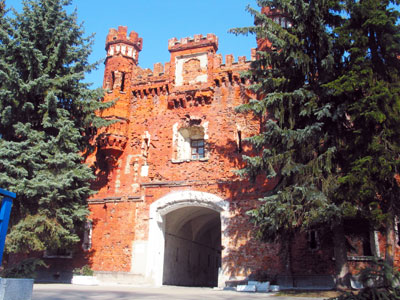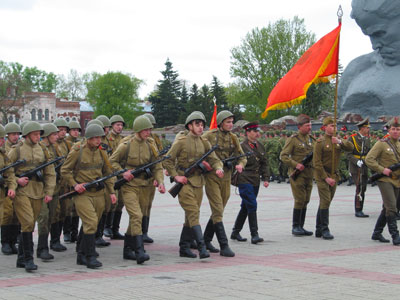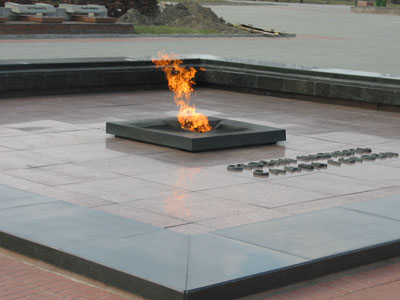Brest Hero Fortress
Memorial complex Brest Hero Fortress



The official website of the state institution Memorial Complex Brest Hero-Fortress
The Soviet government and the people highly appreciated the feat of the defenders of the Brest Fortress. By a decree of the Presidium of the USSR Supreme Council of 8 May 1965 the Brest Fortress was awarded the honorary title of Hero Fortress as well as an Order of Lenin and a Gold Star medal, which are kept forever in the museum of the memorial complex.
The BSSR Council of Ministers set up a creative team in 1967 for the sake of designing the monument. The team was headed by the winner of the USSR Lenin and State Prizes, USSR People's Artist, sculptor Aleksandr Pavlovich Kibalnikov. The creative team included USSR People's Architect V. Korol, BSSR People's Artist, sculptor A. Bembel, Lenin Prize winner, architect V. Zankovich, State Prize winner, architect O. Stakhovich, BSSR State Prize winner, architect G. Sysoyev, the sculptor V. Bobyl, the architects V. Volchek and Y. Kazakov.
25 construction and installation enterprises of the country sent their best specialists to build the memorial. The worker collectives of enterprises, organizations and educational institutions of Brest took an active part in the construction of the memorial complex.
On 18 September 1971 a mourning rally was held in the fortress. The remains discovered during construction in the territory of the memorial together with ashes of the fortress defenders buried earlier in the garrison cemetery were buried with honors under memorial stones.
The solemn opening of the memorial complex Brest Hero Fortress took place on 25 September 1971. The guests of honor included the writer Sergei Sergeyevich Smirnov, who devoted more than 10 years of his life to searching for defenders of the fortress. He returned the names of the fallen heroes to history, became support and a true friend to the survivors. Sergei Smirnov was awarded a Lenin Prize for the book "Brest Fortress", with which generations of readers grew up.
Ruins of the old fortress, sites of firefights, monumental sculptural compositions are combined into a single architectural and artistic ensemble of the memorial, which immortalizes the "legendary story about the heroes of the Brest Fortress".
The main entrance became a kind of overture to the sculptural poem about heroism. A five-pointed star symbolizing military honor and valor is carved into the reinforced concrete block. Under the arches of the main entrance visitors can hear the beat of a metronome counting the last peaceful moments, then the growing rumble of approaching bombers, the deafening howl and the roar of exploding bombs and shells, Aleksandr Aleksandrov’s song Holy War while the announcer Yuri Levitan reads aloud the text of the government message about the treacherous attack launched by Nazi Germany against the Soviet Union.
The central alley leads across the bridge to the Citadel. The sculptural composition Thirst was installed to the left of the bridge on the bank of the Mukhavets River. It symbolically personifies the thirst for life, struggle, and victory. The Ceremonials Square starts at the ruins of the White Palace. The Bayonet obelisk is visible from far away. It is hundred-meter-long and lined with titanium alloy plates to symbolize military courage. Made of reinforced concrete, the main monument 31.5m high and 50m wide rises above ruins of the former Engineering Department. As if protruding from an unfolded banner, the stern look of a warrior mourning for fallen comrades shows great willpower, courage, and unbending determination to stand to the end. On the back side of the monument are bas-reliefs depicting the most striking episodes of the defense of the fortress.
In the center of the architectural ensemble there are three tiers of granite slabs. Beneath them lie the ashes of the 1,022 people who died in the fortress. The names of 276 defenders of the fortress and their families are on the plates. The rest are listed as unknown.
In front of the ruins of the former Engineering Department, in a recess lined with black labradorite, the Eternal Flame burns. The restrained and majestic melody of Schumann's Dreams gives special power to the words inscribed by the Fire: "We fought to the death. Glory to the heroes!" The eternal flame was lit on the opening day of the memorial by Piotr Mironovich Masherov, First Secretary of the Central Committee of the Communist Party of Belarus, Hero of the Soviet Union. A memorial site for hero cities was laid near the Eternal Flame on 9 May 1985.
A great emotional impact on visitors is ensured not only by the musical and sound accompaniment, but also by the evening artistic and decorative lighting of the memorial. Pedestrian paths and the square in front of the main entrance are covered with red plastic concrete. Roses, weeping willows, arborvitae, and silver fir trees are planted in the territory of the memorial.
Over the years of existence of the museum and the memorial, the fortress over the Bug River has become a center of military-patriotic education; many good traditions have developed here. Commemorative units of schools and colleges of the city carry out an honorary watch at the Memory Post. People gather for a rally every year on 9 May, on Victory Day to pay tribute to the fallen and living participants of the Great Patriotic War. Young soldiers of the Brest garrison take the military oath on the sacred land of the fortress. Newlyweds bring flowers on the birthday of a new family. On 1 September student cards are handed out at the Ceremonials Square.
On the territory of the fortress there is the St Nicholas Church. It was transferred to the Brest-Kobrin diocesan administration in 1994. In September 1995 Orthodox Christians once again found spiritual peace in the church. Every year on 22 June a liturgy is served for those killed in this land. Work continues on the overhaul and restoration of the memorial complex and the temple.
People of various ages, beliefs and professions visit the fortress and few of them remain indifferent. Few are not shocked to the depths of their souls by what they see and hear. Opening pages of the history of the Great Patriotic War to the younger generation, the Brest Fortress and its defenders cherish memory of the past and help wisely and responsibly treat the present throughout all these years.





















